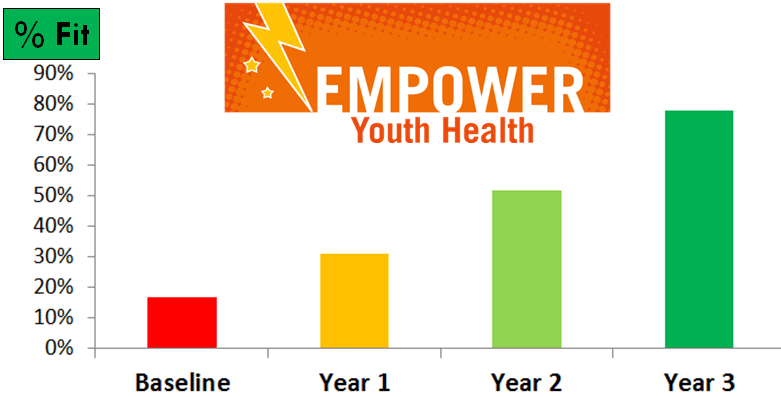Empower Youth Health Program (EYHP)
The Empower Youth Health Program (EYHP) has been operating in Arizona for over 5 years, in K-12 schools with primarily low income, Latino and Native-American populations. EYHP and related components were funded by a federal PEP grant from 2012-15, during which a series of evaluations were conducted.
– Following the introduction of EYHP, the percentage of cardiovascularly fit students increased from under 20% to almost 80% in 3 years—with the percentage of normal weight students increasing 12.5%. This is a major breakthrough nationally. EYHP has been recognized by the CDC and PYFP as a highly effective process.
– Increased fitness from the Empower Youth Health Program delays the onset of and decreases chronic health condition prevalence. Chronic conditions include such devastating diseases as diabetes, obesity, cancer, and heart disease.
– Decreased chronic health conditions can reduce AHCCCS/Medicaid costs in Arizona by more than $200M/year over time, based on 13 years of moderate-to-vigorous physical activity throughout K-12 schooling, and learning lifelong fitness and nutrition habits. When other non-school-based policies are added to reinforce K-12-related policies, savings will exceed $500M/year. Savings begin immediately, and accumulate over time.
– Improved health can add billions to Arizona’s GDP as a “natural economic stimulus”. By reducing chronic health conditions, the Empower Youth Health Program adds back a significant portion of GDP currently lost annually to absenteeism and presenteeism. ($17 billion lost each year in Arizona and $1 trillion nationally, according to the Milken Institute; presenteeism is less productive time at work.)
– For each $1B in increased GDP, state government can expect approximately $100M/year in increased tax revenue, based on current tax-to-GDP ratios. So the Empower Youth Health Program can be expected to add hundreds of millions of dollars over time to state coffers—once implemented statewide, and as the impact is reflected in workforce health & productivity. This money can be used to fund K-12 education, to sustain tax cuts, etc.
– Cost per student at scale for the Empower Youth Health Program is estimated at $10/student/year, with a minimum ROI to the state of 40x, and overall public + private ROI of more than 100x.
– EYHP achieves this in part by training and supporting existing PE and classroom teachers, and developing volunteer student fitness clubs & leaders for peer-led activity. This works within the reality of low numbers of PE minutes, to maximize total minutes of moderate-to-vigorous physical activity—before, during and after school.
– This approach also minimizes new personnel costs needed to implement adequate amounts of exercise. In fact, for schools that have shifted PE time in recent years to classroom instructional time, research shows that schools can re-allocate classroom instructional time back to PE—while improving academic achievement.
– We are assembling a public-private matching funding pool to scale EYHP as soon as possible from 20 schools to at least 90 schools throughout Arizona: minor shared costs/investments, major shared benefits.
– We are using a pay-for-performance “sustained scaling” approach: The state and other EYHP public & private investors choose to renew their commitment to fund annually; on-going outcomes provide evidence to justify renewed investment.
– Health improvement and health cost reduction from EYHP preventive education is expected to bring in at least $300 million in new money to K-12 schools for improved physical and health education. This investment comes from monies, which would have been needed by the federal, state & private health sector to pay for chronic health conditions.
– Much of this funding is paid back during the first year. ROI then increases annually, as children age, and as health risks and costs grow in the adult years.
– The Empower Youth Health Program then continues to demonstrate achievement through regular, objective, nationally validated FitnessGram® or other criterion-referenced assessments. (FitnessGram is the successor to the Presidential Physical Fitness Test, and generally includes PACER “beep test” sprints, push-ups, and crunches. It can also include BMI measurements & other metrics.)
– These fitness-and-health-related assessments then demostrate that EYHP is continuing to increase fitness, as it is scaled.
–EYHP can focus initially on lower-income, high FRL (Free-and-Reduced Lunch) Title 1 schools—which typically face the greatest health challenges and generate the highest state health costs.
– There is on-going 100% accountability, transparency & shared governance throughout.
– The diabetes, child obesity and other chronic conditions epidemics have been raging for over 20 years, harming over 1M people in AZ and 100M nationwide each year.
– 1 out of 3 children in classrooms today will have diabetes as an adult.
– The two biggest unaddressed root causes—lack of exercise and poor nutrition—can only be addressed cost-effectively through our preK-12 schools.
– We need to respond aggressively NOW to the chronic conditions crisis—with high-ROI, proven, evidence-based solutions.
– Now that we have the Empower Youth Health Program, every month delay is a wasted, $$$ lost opportunity for AZ and the nation.
– It is too late to wait. We can’t afford it. We need to scale the Empower Youth Health Program now.
Please click here for the most recent slide deck.
Please click here (or view the slide deck) for more detailed references.
Matt Montoya, PE teacher leading EYHP at Desert View HS, Tucson
Jesus, HS student in Empower Youth Health Program
Example: GoNoodle in-classroom next-to-desk music video exercise
FitnessGram PACER “beep” test description & footage
(Please see our latest slide deck for more details, as well as this list of research evidence references.)





